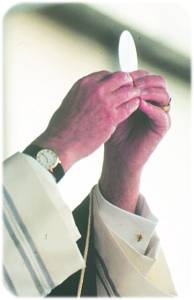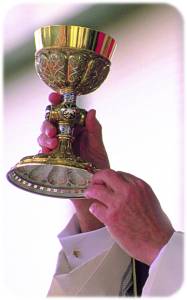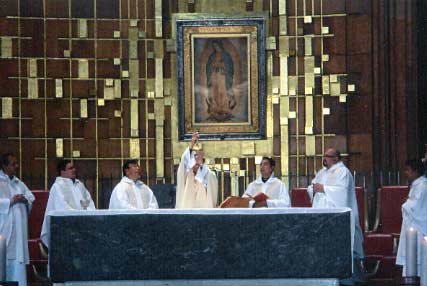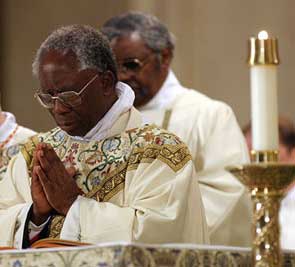 |

"The Crucifixion"
by Carl Heinrich Bloch, 1870
 |
Mass and Liturgy |
 |
To defend this basic Eucharistic mystery, the Council of Trent made a series of definitions. Originally drafted as negative anathemas, they may be reduced to the following positive affirmation of faith.
 Relation of the Mass to Calvary. In order to see how the Mass
is related to Calvary, we must immediately distinguish between the actual Redemption
of the world and the communication of Christ's redemptive graces to a sinful
human race.
Relation of the Mass to Calvary. In order to see how the Mass
is related to Calvary, we must immediately distinguish between the actual Redemption
of the world and the communication of Christ's redemptive graces to a sinful
human race.
On the Cross, Christ really redeemed the human family. He is the one true Mediator between God and an estranged humanity. On the Cross, He merited all the graces that the world would need to be reconciled with an offended God.
When He died, the separation of His blood from His body caused the separation of His human soul from the body, which caused His death. He willed to die in the deepest sense of the word. He chose to die. In His own words, He laid down His life for the salvation of a sinful mankind.
But His physical death on Calvary was not to be an automatic redemption of a sin-laden world. It would not exclude the need for us to appropriate the merits He gained on the Cross; nor would it exclude the need for our voluntary cooperation with the graces merited by the Savior's shedding of His blood.
The key to seeing the relation between Calvary and the Mass is the fact that the same identical Jesus Christ now glorified is present on the altar at Mass as He was present in His mortal humanity on the Cross.
Since it is the same Jesus, we must say He continues in the Mass what He did on Calvary except that now in the Mass, He is no longer mortal or capable of suffering in His physical person. On Calvary He was, by His own choice, capable of suffering and dying. What He did then was to gain the blessings of our redemption. What He does now in the Mass is apply these blessings to the constant spiritual needs of a sinful, suffering humanity.
Before we look more closely at the Mass as a sacrifice of propitiation and petition, we should make plain that it is first and foremost, a sacrifice of praise (adoration) and thanksgiving. No less than He did on Calvary, in the Mass Jesus continues to offer Himself to the heavenly Father. Since the highest form of honor to God is sacrifice, the Mass is a continuation of Christ's sacrifice of praise and gratitude to God the Father. But, whereas on Calvary, this sacrificial adoration was bloody, causing Christ's physical death by crucifixion, in the Mass the same Jesus is now sacrificing Himself in an unbloody manner because he is now glorified, immortal, and incapable of suffering or dying in His own physical person.
We now turn from the Mass as a sacrifice of adoration and thanks (referring to God), to the Mass as a sacrifice of propitiation and petition (referring to us).
Notice we use two words, propititation and petition. They are not the same.
The Mass a True Sacrifice. Since the first century of her existence, the Church has considered the Mass a sacrifice. The earliest manual of the
liturgy (before 90 A.D.) has this directive for the attendance of Sunday Mass.
"On the Lord's own day, assemble in common to break bread and offer thanks. But first confess your sins so that your sacrifice may be pure. However, no one quarreling with his brother may join your meeting until they are reconciled; your sacrifice must not be defiled (Teaching of the Twelve Apostles, 14)."
Why is the Mass a true sacrifice? Because in the Mass the same Jesus Christ who offered Himself on Calvary now offers Himself on the altar. The Priest is the same, the Victim is the same, and the end or purpose is the same.
The Priest is the same Jesus Christ whose sacred person the ordained priest represents and in whose Name he offers the Eucharistic Sacrifice.
The Victim is the same, namely the Savior in His human nature, with His true Body and Blood, and His human free will. Only the manner of offering is different. On the Cross, the sacrifice was bloody; in the Mass it is unbloody because Christ is now in His glorified state. But the heart of sacrifice is the voluntary, total offering of oneself to God. Christ makes this voluntary offering in every Mass, signified by the separate consecration of the bread and wine into the Body and Blood of the Redeemer.
The end or purpose is the same, namely to give glory to God, to thank Him, to obtain His mercy, and to ask Him for our needs. But, as we have seen, whereas on Calvary Christ merited our salvation, it is mainly through the Mass that He now dispenses the riches of His saving grace.
| Sancta Missa-Tutorial on the Latin Mass According to the 1962 Missale Romanum "It is our hope that this tutorial will assist Priests to learn how to offer the Tridentine Mass and for the Faithful, to learn how to pray the Mass with greater devotion and fervor." |
 |
||
| Mass Times This place is the definitive resource for finding out what time Masses are held at churches and tourist locations throughout the United States. Not only is this a great resource for the business traveler or vacationer, but it also comes in handy when you need to know what time Masses are being held in the local churches around the area where you live. |
|||
| The Sacrifice of the Mass - Fr. John A. Hardon, S.J. "My plan is to see something of the riches of faith revealed to us in the mystery of the Mass as sacrifice…And all the while, in reflecting on the mystery of the Mass from these different perspectives, we should apply the insights to ourselves." |
|||
| The Instruction ‘Redemptionis Sacramentum’ — III - Archbishop Raymond L. Burke By virtue of the grace of the Sacrament of Baptism, which is strengthened and increased by the Sacrament of Confirmation, all of us are called to offer worship to God, especially through the Eucharistic Sacrifice. Worship of God, that is, participation in the Holy Mass, is, in fact, the greatest service we give in the Church. By our participation in the Holy Eucharist, we unite ourselves to Christ in His Sacrifice, pouring out our lives, with Him, in love of God and our neighbor. |
|||
| Transubstantiation - Fr. John A. Hardon, S.J. (MP3 File) Fr. Hardon, who was Blessed Mother Teresa's spiritual director, was asked by Sister Fredrick to give a talk on the definition of Transubstantiation to the Missionaires of Charity who were preparing for their final vows in Calcutta India in 1997. This audio is a half hour extract from that talk which is a response to a question: What do you mean by this statement, "The physical property of Christ's human nature is present in the Holy Eucharist?" on 11/29/97 Class #3 on the Sacrament of the Holy Eucharist and the document "Mysterium Fidei". Please note the following copyright notice before downloading the file: Copyright © 1997 Inter Mirifica Inc. |
|||
| The Priesthood of the Faithful - Fr. John A. Hardon, S.J. "The Mass, being in the vernaclular, now brings out more clearly than ever the intimate participation of the faithful in the Holy Sacrifice.…They [the faithful] participate in the priesthood. The question is how? It is worth going into this subject because it is part of divine revelation." |
|||
| How to Make the Mass More Vital in the Religious Life - Fr. John A. Hardon, S.J. "…our answer is or should be, we make the Mass more vital in our religious life by knowing the Mass, second by living the Mass and thirdly, by participating in the Mass." |
|||
| Holy Mass - Holy Innocents: The Holy Sacrifice
Versus Human Sacrifice - Fr. John A. Hardon, S.J. "The title of our present meditation is certainly strange. In fact, it is really two titles wrapped in one. Both parts of the title are contrasts. The first is between the Holy Mass and the innocents who were killed by King Herod. The second is a contrast between the sacrifice of Christ and the sacrifices of human beings." |
|||
| Kneeling and Faith in the Eucharist - Regis Scanlon (EWTN) |
|||
| The Mass - Fr. Mateo Crawley-Boevey,
SS.CC. (Immaculata Magazine) |
|||
| The Redeeming Power of the Mass - (Holy Face Association) |
|||
| EWTN: The Eucharist - has several introductory articles on the Mass and Communion |
|||
| Daily Word Catholic Mass Readings - (CIN) |
 |
||
| Search EWTN Libraries for mass, liturgy - (many articles) |
|||
| Articles on the Mass - (The Catholic Pages) |
|||
| The Institution of the Mass - (Catholic Answers) |
|||
| The Sacrifice of the Mass - (Catholic Answers) |
|||
| The Order of Mass - Basic Texts for the Roman Catholic Eucharist - (Catholic Resources) |
|||
| Celebration of Mass - (Archdiocese of St. Louis - Enter : Celebration of Mass) |
|||
| The Sunday Eucharist is the Testimony of Charity - Papal Address at Rome's Diocesan Conference (Zenit) The Eucharist is the memorial of the Death and Resurrection of Jesus Christ, of his love to the end for each one of us, memorial that He willed to entrust to the Church so that it would be celebrated throughout the centuries. According to the meaning of the Hebrew word "zakar," the "memorial" is not simply the memory of something that happened in the past, but a celebration which actualizes that event, so as to reproduce its salvific force and efficacy. |
|||
| ADOREMUS: Society for the Renewal of the Sacred Liturgy
- according to Vatican II (Adoremus) |
|||
|
What Is Liturgy Supposed to Be and Do? - by Peter A. Kwasniewski (The Catholic Faith) |
|||
|
Liturgy of the Hours (The Liturgy of the Hours Apostolate) |
|||
|
Universalis - This site uses the version of the Liturgy of the Hours given in the Roman Breviary and does all the calendar calculations for
you, and presents you with the psalms and readings for each hour of today, every day. |
|||
|
The Catholic Liturgy Library - This site is dedicated to providing accurate historical and current
information about the liturgies of the Latin (Roman) rite of the Catholic Church. |
|||
|
Meeting Christ in the Liturgy - (MCITL) |
|||
|
Sacred Music - Reflections on Sacred Music and the Liturgy - Peter A. Kwasiewski (EWTN) |
|||
|
Catholic Information Network: Liturgy and Prayer - links to various liturgy and mass resources (CIN) |
|||
|
The Scandal of the Liturgy - book by Joseph Cardinal Ratzinger, reviewed by Fr. Paul Scalia (Adoremus Bulletin) |
|||
|
Kneeling and Faith in the Eucharist - Fr. Regis Scanlon (EWTN) |
|||
|
The Latin Liturgy Association - promotes the use of Latin in the liturgy |
|||
|
Coalition for the support of Ecclesia Dei |
|||
| Guidelines for Church Architecture - Tabernacle Placement
- Bishop Raymond Burke of the Diocese of La Crosse (Adoremus Bulletin) |
|||
| Placing of the Tabernacle
- Fr. George Saunders (EWTN) |
|||
| Church Documents on the Mass and Liturgy |
|||
|
The painting of The Crucifixion by Carl Bloch is used with the permission of Det Nationalhistoriske Museum på Frederiksborg, Hillerød, Denmark Photos of the Holy Father are © Grzegorz Galazka and used with permission of Inside theVatican magazine, 1-800-789-9494. |
Adorers Society | PEA Manual | Essentials of Faith | Dictionary | Thesaurus | Catalog | Newsletters
|
Real Presence Eucharistic Education and Adoration Association
718 Liberty Lane Lombard, IL 60148 Phone: 815-254-4420 Contact Us Internet: www.therealpresence.org Copyright © 2000 by www.therealpresence.org All rights reserved worldwide. No part of this publication may be reproduced, stored in a retrieval system, or transmitted, in any form or by any means, electronic, mechanical, photocopying, recording or otherwise, without the prior written permission of www.therealpresence.org |